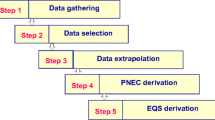Abstract
The San Francisco Estuary Regional Monitoring Program (RMP) for Trace Substances is an innovative partnership among a regulatory agency, more than 70 regulated entities, and an independent scientific organization. The institutional arrangement behind the RMP has made the regulatory system increasingly responsive to emerging management needs, particularly with regard to the development of total maximum daily loads and ecosystem impairment assessment. Through multi-agency partnerships within and outside the RMP institutional structure, major information gaps for several pollutants of concern have been narrowed, resulting in a successful consensus-based regulatory approach to managing copper and nickel mass inputs into the Estuary. Short-term research efforts, based upon monitoring results, helped identify the most cost-effective control and remediation options for various bioaccumulative substances. Additionally, adaptive changes to the monitoring program documented the existence of widespread aquatic toxicity in the Estuary that is apparently due to pesticide runoff from agricultural and urban areas. One of the most important contributions of this collaborative monitoring program is the deliberate and systematic adjustment of management and research questions that serve to influence and add relevance to the overall research agenda related to San Francisco Estuary ecosystem assessment.
Similar content being viewed by others
References
Abu-Saba, K.E. and Tang, L.W.: 2000, Watershed Management of Mercury in the San Francisco Bay Estuary: Total Maximum Daily Load Report to U.S. EPA. California Regional Water Quality Control Board, San Francisco Bay Region, Oakland, CA.
Bernstein, B.B., Thompson, B.E. and Smith, R.W.: 1993, ‘A Combined Science and Management Framework for Developing Regional Monitoring Objectives’. Coastal Management 21, 185–195.
Bernstein, B.B. and O'Connor, J.: 1997, Five-year program review of the Regional Monitoring Program for Trace Substances in the San Francsico Estuary, RMP Contribution #28, San Francisco Estuary Institute, Richmond, CA.
Bernstein, B.B., Hoenicke, R. and Tyrrell, C.: 1997, ‘Planning Tools for Developing Comprehensive Regional Monitoring Programs’, Environmental Monitoring and Assessment 48, 297–306.
Darnerud, P.O., Eriksen, G.S., Johannesson, T., Larsen, P.B. and Viluksela, M.: 2001, ‘Polybrominated Diphenyl Ethers: Occurrence, Dietary Exposure, and Toxicology’, Environmental Health Perspectives 109, 49–68.
Davis, J.A.: 2002, A PCB Budget for San Francisco Bay. San Francisco Estuary Institute, Richmond, CA.
Eichbaum, W.M. and Bernstein, B.B.: 1990, ‘Current Issues in Environmental Management: A Case Study of Southern California's Marine Monitoring System’, Coastal Management 18, 433–445.
Healey, M.C. and Hennessy, T.M: 1994, ‘The Utilization of Scientific Information in the Management of Estuarine Ecosystems’, Ocean and Coastal Management 23, 167–191
Johnson, G. W., Jarman, W. M., Bacon, C.E., Davis, J.A., Ehrlich, R. and Risebrough, R. W.: 2000, ‘Resolving Polychlorinated Biphenyl Source Fingerprints in Suspended Particulate Matter of San Francisco Bay’, Environmental Science and Technology 34, 552–559.
Ludwig, D., Hilborn, R. and Walters, C.: 1993, ‘Uncertainty, Resource Exploitation, and Conservation: Lessons from History’, Science 260, 17–36.
Mackay, D., Sang, S., Vlahos, P., Diamond, M., Gobas, F. and Dolan, D.: 1994, ‘A Rate Constant Model of Chemical Dynamics in a Lake Ecosystem: PCBs in Lake Ontario’, Journal of Great Lakes Research 20, 625–642.
National Research Council (NRC): 1990a, Managing Troubled Waters, Washington, D.C.: National Academy Press.
National Research Council (NRC): 1990b, Monitoring Southern California's Coastal Waters: A Case Study. Washington, D.C.: National Academy Press.
National Research Council (NRC): 1993, Managing Wastewater in Coastal Urban Areas. Washington, D.C.: National Academy Press.
Ogle, S., Gunther, A., Hoenicke, R., Bell, D., Cotsifas, J, Gold, J. and Salop, P.: 2001, RMP Summary Report on Episodic Ambient Water Toxicity in the San Francisco Estuary. San Francisco Estuary Institute, Richmond, CA.
Olivieri, A., Hall, T., Bruinsma, D., Hoenicke, R., Munley, T., Grieb, T.:2000, ‘TMDL as a Regulatory Process: Conducting the Copper and Nickel TMDL in South San Francisco Bay,’ Proceedings of the Watershed 2000 Specialty Conference. Vancouver, B.C.
San Francisco Estuary Institute: 2001, The Pulse of the Estuary-Monitoring and Managing Contamination in the San Francisco Estuary 1993–1999. Richmond, CA
Thompson, B.E., Hoenicke, R., Davis, J.A. and Gunther, A.: 2000, ‘An Overview of Contaminant-related Issues Identified by Monitoring in San Francisco Bay’, Environmental Monitoring and Assessment 64, 409–419.
U.S. Forest Service, 1999, The Strategy and Design of the Effectiveness Monitoring Program for the Northwest Forest Plan, General Technical Report PNW-GTR-437.
Author information
Authors and Affiliations
Rights and permissions
About this article
Cite this article
Hoenicke, R., Davis, J.A., Gunther, A. et al. Effective Application of Monitoring Information: The Case of San Francisco Bay. Environ Monit Assess 81, 15–25 (2003). https://doi.org/10.1023/A:1021344117229
Issue Date:
DOI: https://doi.org/10.1023/A:1021344117229




